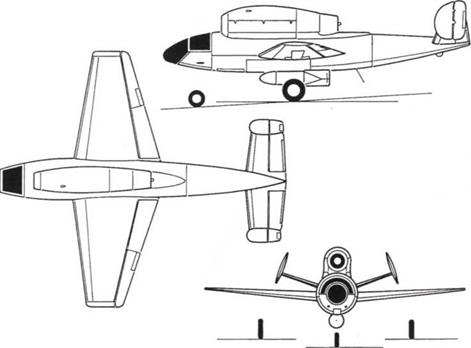New Ideas and Designs
Besides the inadequate numbers of Blitzbombers, much lighter machines were designed. In the long run dwindling supplies of materials prevented the mass production of machines such as the Me 262. What was needed was a far cheaper solution which could be made operational in large numbers. OKL was thinking here principally of small, nimble aircraft which would be difficult for enemy AA defences, fighter pilots and air gunners to sight. Quite a few ideas were thus in the wind at the end of 1944. Mass producing mixed construction He 132s and giving the Junkers EF 126 its chance were proposals which accompanied thoughts of using the He 162 as a Jabo or arming the future Та 183 with bomb containers. No stone was to be left unturned.
Henschel Hs 132
Without doubt the Hs 132, a new kind of one-man bomber powered by a BMW 003-1 (Hs 132A), Jumo 004 B-2 (Hs 132B) or the far more powerful HeS Oil A-l (Hs 132C), was amongst the most advanced designs at the beginning of 1945. Of mixed materials, the planned machine would have carried the pilot in the prone position and protected by a massive 75-mm armoured glass plate direcdy before him. The pilot s tub was well armoured against hits from below, and could be lowered to enable him to enter and leave the machine comfortably once on the ground. If necessary the pilot had space to bale out through the tub opening. In the course of a wheels-up landing only a relatively small escape hatch on the upper side of the cabin was available, a less favourable option.
In order to reduce Hs 132 production costs, only the fuselage was to be built using expensive light metals. The wings were to be steel or wood. Main armament was to be two MG 15 l/15s with 250 rounds each. A 500-kg bomb could be carried easily below the fuselage. In action as a Jabo against less well – armoured targets two 50-kg bombs in disposable containers could be mounted outboard. If an HeS 011 powerplant had been available, the fixed weaponry would have been four MG 151s and a bomb of up to 1,000 kg. The use of
|
|
General arrangement drawing of the Hs 132 A-l. Its planned series production was abandoned as the end neared.
Panzerblitz rockets fired from simple wooden racks was also considered. The development of the Hs 132 began as project study HsP 123 in the summer of 1943. At the beginning of April 1944 a full-scale mock-up of the proposed short- range aircraft was inspected closely by RLM and KdE representatives. At the end of August it was decided that the aircraft should be used as a Jabo.
By November 1944 the fuselage of the first test aircraft was almost complete, and the wind-tunnel studies were carried out at Gottingen aerodynamic test institute (AVA) using a one-sixth scale model. These tests showed that the planned aircraft, at least in its original form, would be nose-heavy, and a prone pilot would probably have had no chance of escaping his narrow cabin in the event of an emergency. Work on the first experimental aircraft was under way by the end of 1944, and the first of these, Hs 132 M-l, was scheduled for testing at Schonefeld in March. After the Henschel design bureau was transferred to Silesia, and the wing/tailpane factory in Saxony damaged by bombing, series production became less likely, and in the spring of 1945 testing was postponed indefinitely.
The Red Army impounded the partially complete but lightly damaged fuselage of Hs 132 Ml at Berlin Schonefeld. As neither the Heinkel turbines nor the wings from Dresden ever arrived because the factories had been captured, the prototype remained a wingless fuselage, as did two other specimens at the Berlin manufacturer. In July 1946 these were discovered in a cellar in their component parts and packed in cases. The fuselage of the third prototype, complete but for wooden wings and tailplane, made the best impression on Russian engineers. Hs 132 M-3 was shipped off to the Soviet Union where its subsequent fate, and that of the other parts, is unknown. Possibly they were scrapped at the end of the 1940s. A similar fate was met by the other light jet, Ju EF 126, due to join the Luftwaffe ranks in the summer of 1945. It was simpler than the Hs 132, and was therefore even more suitable for mass production.











